What Is Clean Eating Explained
Wondering what is clean eating? This simple guide breaks down the principles, benefits, and myths to help you start a healthier lifestyle today.
Ready to Simplify Your Meal Planning?
Get personalized meal plans and grocery lists automatically matched to your macro targets.
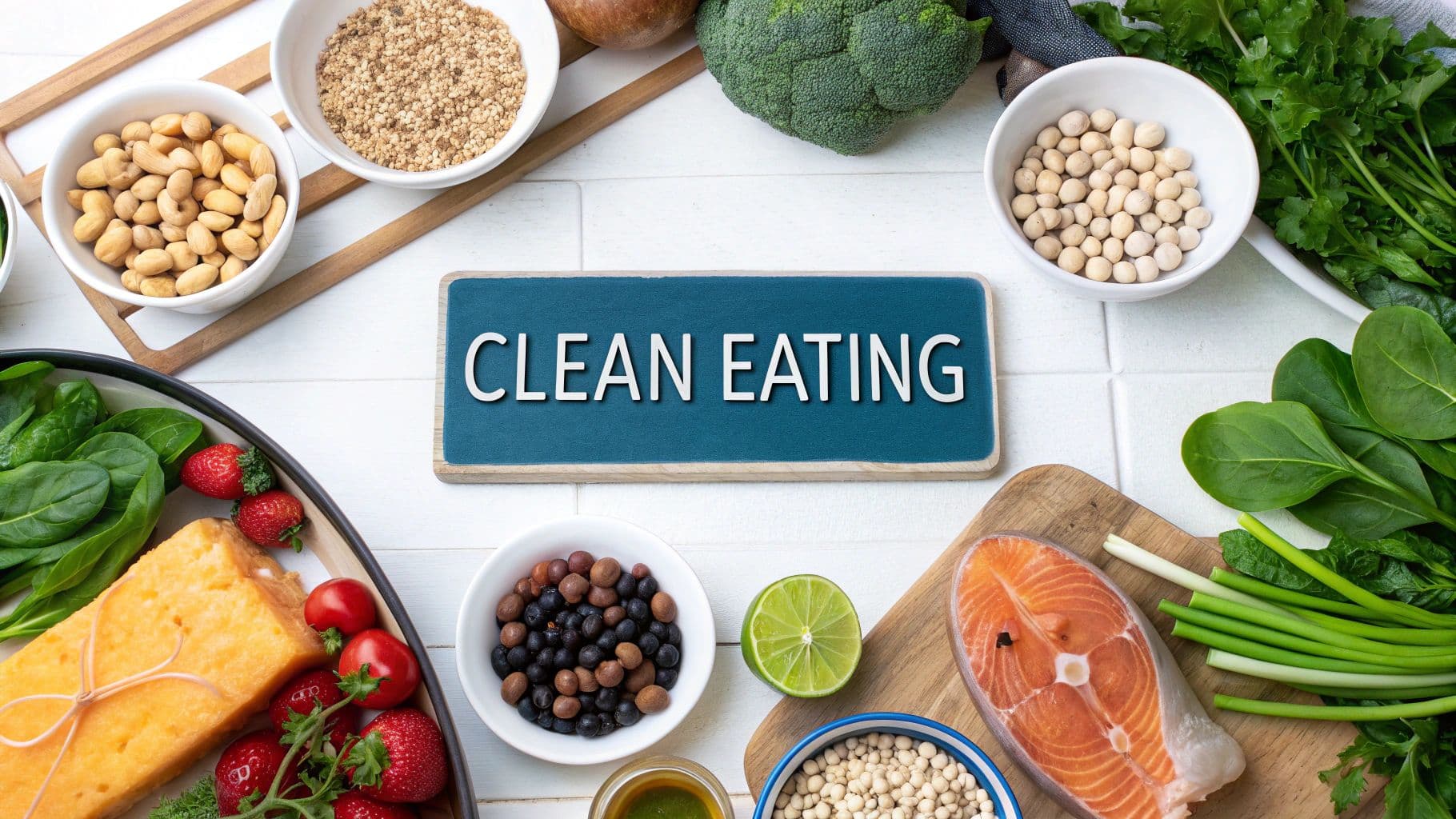
So, what is clean eating? In a world full of fad diets and complicated rules, the answer is refreshingly simple. It’s all about choosing foods that are as close to their natural state as possible. Think bright, crunchy vegetables, juicy fruits, whole grains, and lean proteins.
It's a shift in mindset, not a strict diet. Forget about calorie counting or forbidden food groups. Clean eating is about nourishing your body with real, wholesome ingredients and sidestepping the heavily processed stuff full of artificial additives, preservatives, and refined sugars.
Let's Break It Down
Think of it this way: your body is a high-performance engine. You wouldn't fill a Ferrari with low-grade, sludgy fuel, would you? Clean eating is simply choosing premium fuel—foods that are minimally altered from how they grew in the ground or roamed the fields.
This idea really took off in the early 2010s as more people started questioning what was actually in their food. It’s not about perfection; it's about making a conscious choice to eat more real food and less of the lab-created stuff. Instead of a sugary granola bar from a box, you might grab a handful of nuts and an apple. It’s that simple. You can dive deeper into the healthy food market trends here.
This handy infographic sums it up beautifully, showing the simple swaps that make all the difference.
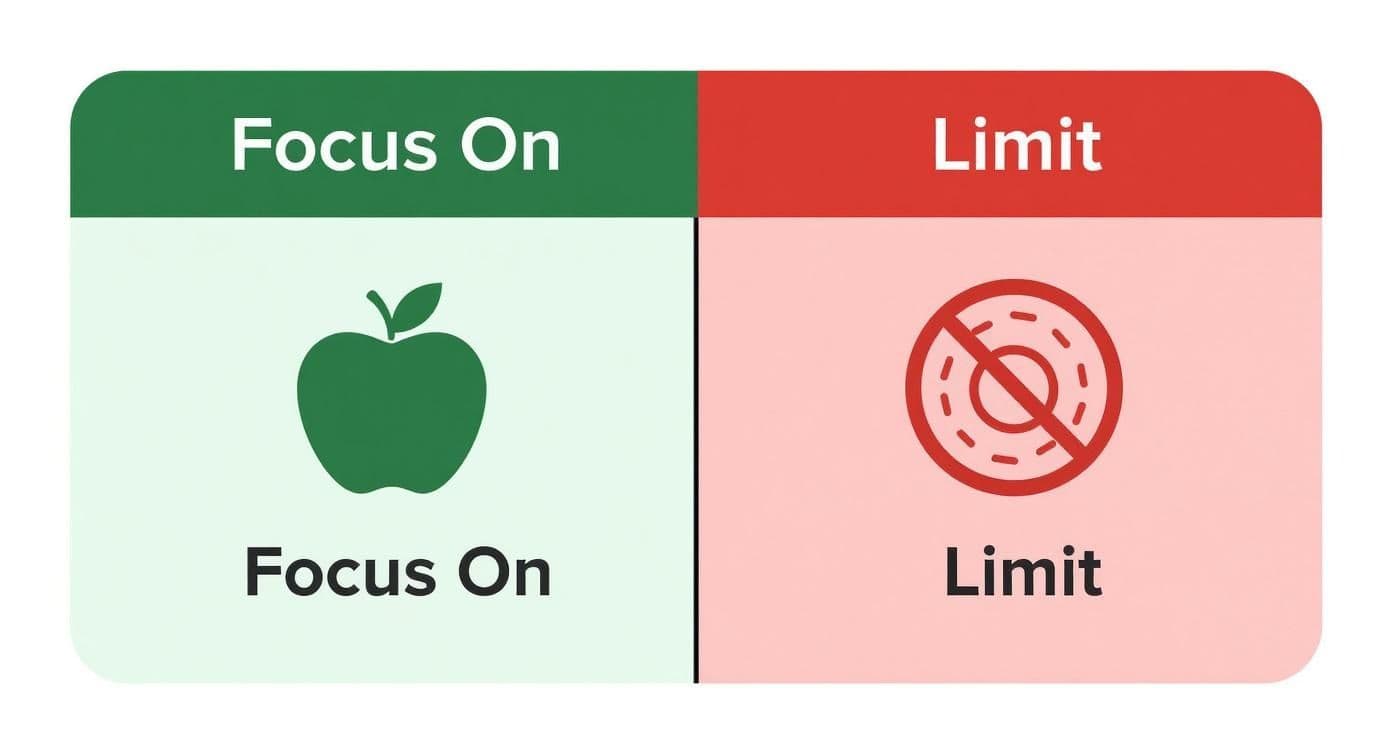
As you can see, it’s an intuitive switch. An apple is just an apple. A donut, on the other hand, has gone through a lot of changes to get to your plate. Clean eating is about favoring the apple.
At its heart, clean eating is about being mindful. It’s paying attention to what you’re eating and appreciating where your food comes from. It's about trading processed for fresh, and complicated for simple.
For a quick reference, this table breaks down the core idea into what you should be reaching for and what you might want to enjoy less often.
Clean Eating At a Glance
| Focus On (Eat More) | Limit or Avoid (Eat Less) |
| Whole Fruits & Vegetables: Fresh, frozen, or canned in water. | Highly Processed Foods: Frozen dinners, packaged snacks, sugary cereals. |
| Lean Proteins: Chicken, fish, beans, lentils, tofu. | Refined Grains: White bread, white pasta, pastries. |
| Whole Grains: Brown rice, quinoa, oats, whole-wheat bread. | Added Sugars & Sweeteners: Sodas, candy, many packaged sauces. |
| Healthy Fats: Avocados, nuts, seeds, olive oil. | Artificial Ingredients: Preservatives, colorings, flavorings. |
| Water & Herbal Teas: Staying hydrated naturally. | Trans Fats & Processed Oils: Found in fried foods and many baked goods. |
Ultimately, this isn't an all-or-nothing game. It's about making small, consistent choices that add up over time, helping you feel more energetic and vibrant. By loading your plate with whole foods, you're naturally boosting your intake of vitamins, minerals, and fiber—the building blocks for a healthier you.
The Unspoken Rules of Clean Eating
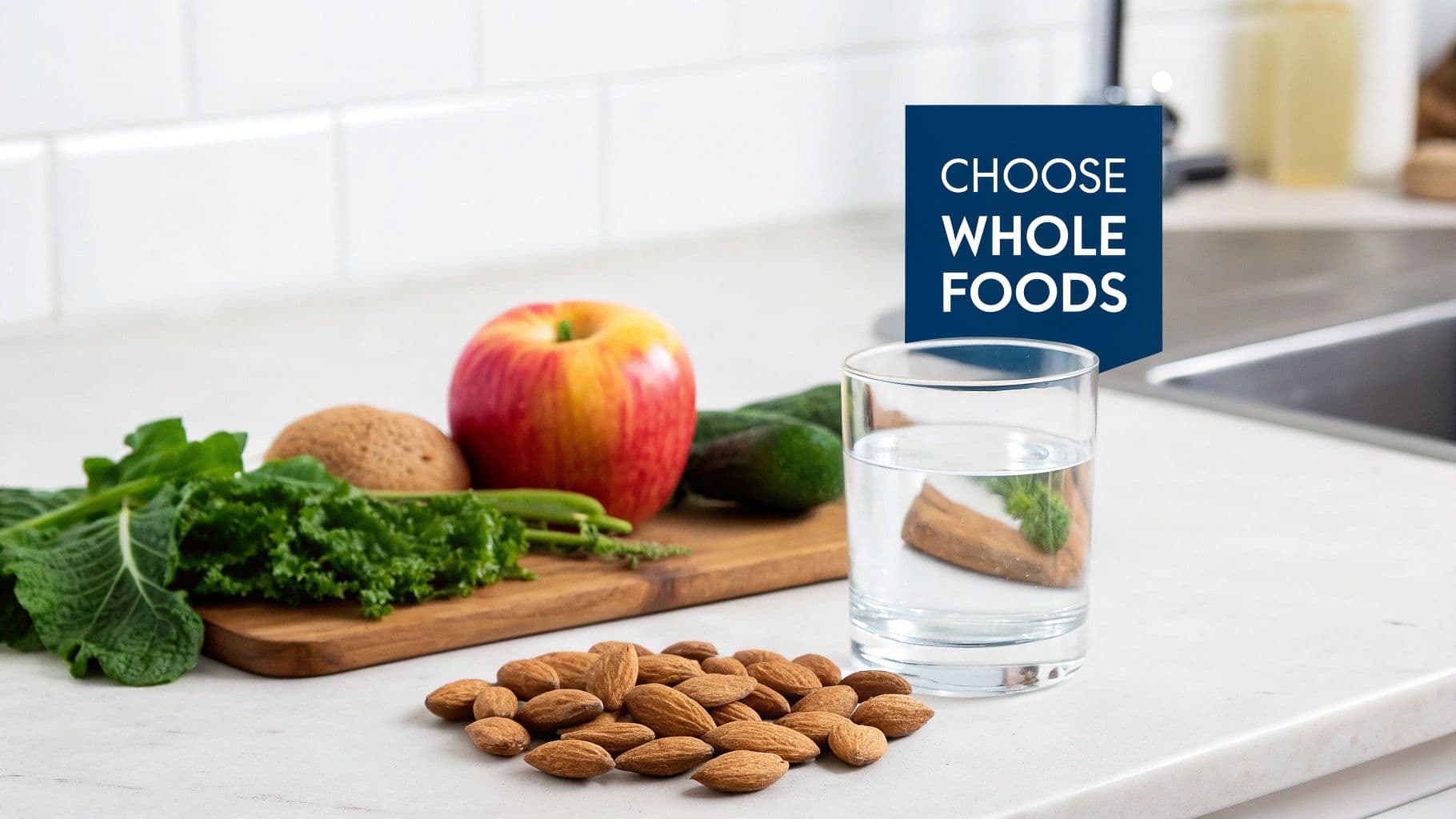
Alright, so the concept of clean eating makes sense. But what does it actually look like when you’re staring down a grocery store aisle, trying to decide what to put in your cart? It's not about memorizing a giant, complicated rulebook. Think of it more like having a few core principles in your back pocket to guide your choices.
The big one—the absolute cornerstone—is to prioritize whole foods. This just means choosing foods that look as close as possible to how they came out of the ground or off the farm. Picture a bright red apple versus a box of apple-flavored fruit snacks, or a simple grilled chicken breast next to a frozen, breaded chicken nugget. The apple and the chicken breast? Whole foods. The other stuff has been through the factory ringer.
Read Labels Like a Pro
To actually stick with whole foods, you’ve got to get a little nosy with packaging. Reading nutrition labels is your superpower here. Food manufacturers are pros at sneaking in sugars and funky additives with names you can't even pronounce.
A simple trick I love is the five-ingredient rule: if a packaged item has more than five ingredients, or if you see words you wouldn't find in your own kitchen, it's probably not the cleanest choice you can make. A bag of almonds should just say "almonds." The "smoky BBQ" version, on the other hand, might have a laundry list of powders, flavorings, and preservatives. That's your cue to put it back.
The goal isn’t perfection, but progress. Swapping just one processed snack a day for a whole-food alternative—like trading a protein bar for a handful of walnuts—is a massive win for your well-being.
Make Water Your Go-To Drink
Let's not forget what you're sipping on. It's so easy to undo all your good work with sugary drinks. Sodas, sweetened coffees, and most fruit "juices" are basically liquid candy, packed with empty calories and artificial sweeteners that can throw you completely off track.
Making water your main squeeze is a non-negotiable part of clean eating. It’s the ultimate multi-tasker: it helps flush out junk, keeps your digestion humming, and your energy levels from cratering. If plain H2O feels like a total bore, spice it up!
- Infuse it: Toss in some slices of lemon, cucumber, or a few mint leaves. It’s a total game-changer.
- Go bubbly: Unsweetened sparkling water gives you that fizzy fix without the junk.
- Brew it: Herbal teas like peppermint or chamomile are fantastic, flavorful, and super hydrating.
When you nail these three things—whole foods, smart label reading, and hydration—you're building an incredibly strong foundation. It stops feeling like a "diet" and starts feeling like you're just making a series of smart, empowering choices that really add up.
Why Your Body Loves Clean Eating
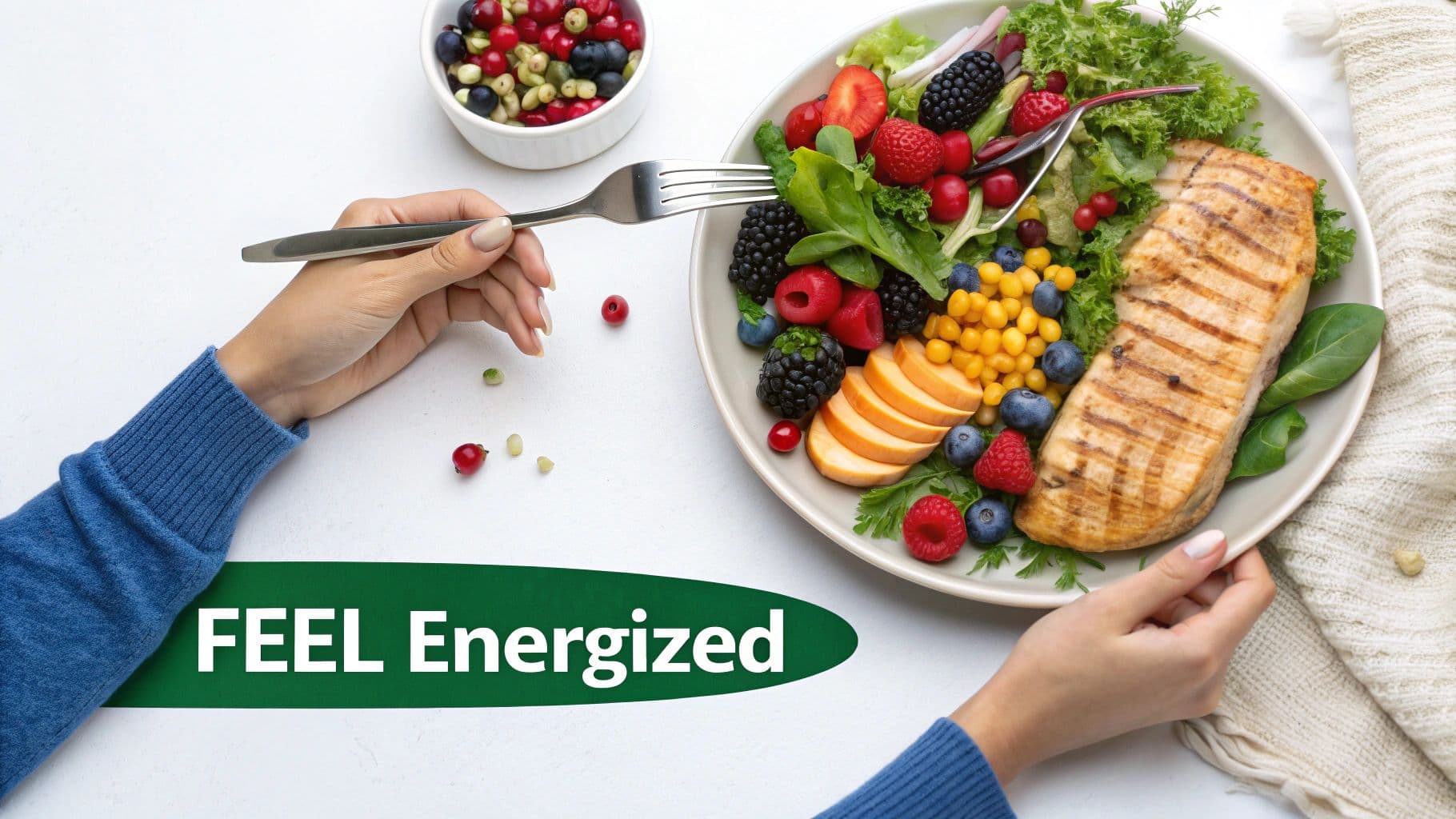
Okay, so we know what clean eating is. But the real game-changer is understanding why it works so well. It’s simple, really.
Imagine your body is a high-performance sports car. If you fill it with premium fuel—whole, nutrient-rich foods—it’s going to run like a dream. But if you pump it full of cheap, processed junk? You’ll get sputtering energy, sluggish performance, and maybe even a few breakdowns.
This isn't just a clever analogy; it’s pure biology. When you trade processed carbs and refined sugars for whole grains, fruits, and veggies, you give your body a slow-burning, steady source of fuel. That means no more 3 PM energy crashes. Just consistent, reliable power to get you through your day.
It's Not Just About Energy
The perks of clean eating go way beyond just feeling less tired. When you give your body the tools it needs to do its job, you start seeing positive changes everywhere.
Here are just a few of the upgrades you can expect:
- Happy Digestion: All that fiber from whole foods keeps things moving along smoothly. No more awkward bloating or discomfort.
- A Sharper Mind: Your brain thrives on healthy fats and antioxidants, which helps blow away that pesky mental fog.
- Glowing Skin: The nutrients packed into fresh produce can calm inflammation and help you get that healthy, clear complexion.
One of the biggest wins is what happens to your gut. Think of your gut as the command center for your entire body—it affects everything from your immune system to your mood.
Feeding it clean, fiber-rich foods helps create a healthy, balanced internal environment. It’s no wonder gut health has become such a hot topic, with nearly 40% of consumers globally now seeing it as a key to overall wellness. If you're curious, you can explore more insights into the health and wellness food market here.
Suddenly, the motivation to eat clean feels less like a chore and more like a no-brainer.
Let's Bust Some Clean Eating Myths
Let's be real for a second. The term "clean eating" can sound… well, a little intimidating. It conjures up images of ridiculously expensive grocery trips and sad, flavorless meals. That's enough to make anyone say, "No thanks!"
But most of that is just noise. It’s time we bust a few of the biggest myths that stop people from giving this incredibly simple and effective way of eating a fair shot.
The most common misconception? That clean eating is some exclusive club for the wealthy. That couldn't be further from the truth. While specialty organic items can have scary price tags, the heart of clean eating is all about affordable MVPs like beans, lentils, oats, and whatever produce is currently in season.
Myth 1: It Costs a Fortune
Thinking you need a bottomless wallet is probably the number one reason people get scared off. But I'm here to tell you that you can be a total budget superstar and still eat clean.
Here’s the game plan:
- Embrace the Freezer Aisle: Seriously. Frozen fruits and veggies are picked at their prime and are often cheaper than fresh, without losing their nutritional punch.
- Go Big with Bulk: Things like brown rice, quinoa, and dried beans are dirt cheap when you buy them from the bulk bins.
- Have a Plan: A simple weekly meal plan is your secret weapon. You buy only what you need, which means less food waste and fewer impulse buys.
Myth 2: It's an All-or-Nothing Game
This one is just paralyzing. The idea that you have to be perfect 100% of the time is totally unrealistic and a recipe for disaster. Clean eating isn't a rigid diet with a pass/fail grade; it's a flexible approach to feeling good.
The 80/20 rule is a lifesaver for so many people. You aim to eat clean, whole foods 80% of the time, and that leaves a guilt-free 20% for that slice of birthday cake or a spontaneous Friday night pizza. It's about balance, not perfection.
And finally, we have to tackle the myth that clean food equals bland food. This one is just flat-out wrong. Have you ever tried roasting vegetables with a little garlic and herbs until they're caramelized and sweet? Or grilling chicken with a zesty lemon marinade?
Spices, herbs, and healthy fats are your new best friends. They turn the simplest ingredients into meals you'll actually look forward to eating. Clean eating is about celebrating natural flavors, not sacrificing them.
Your First Week of Eating Clean
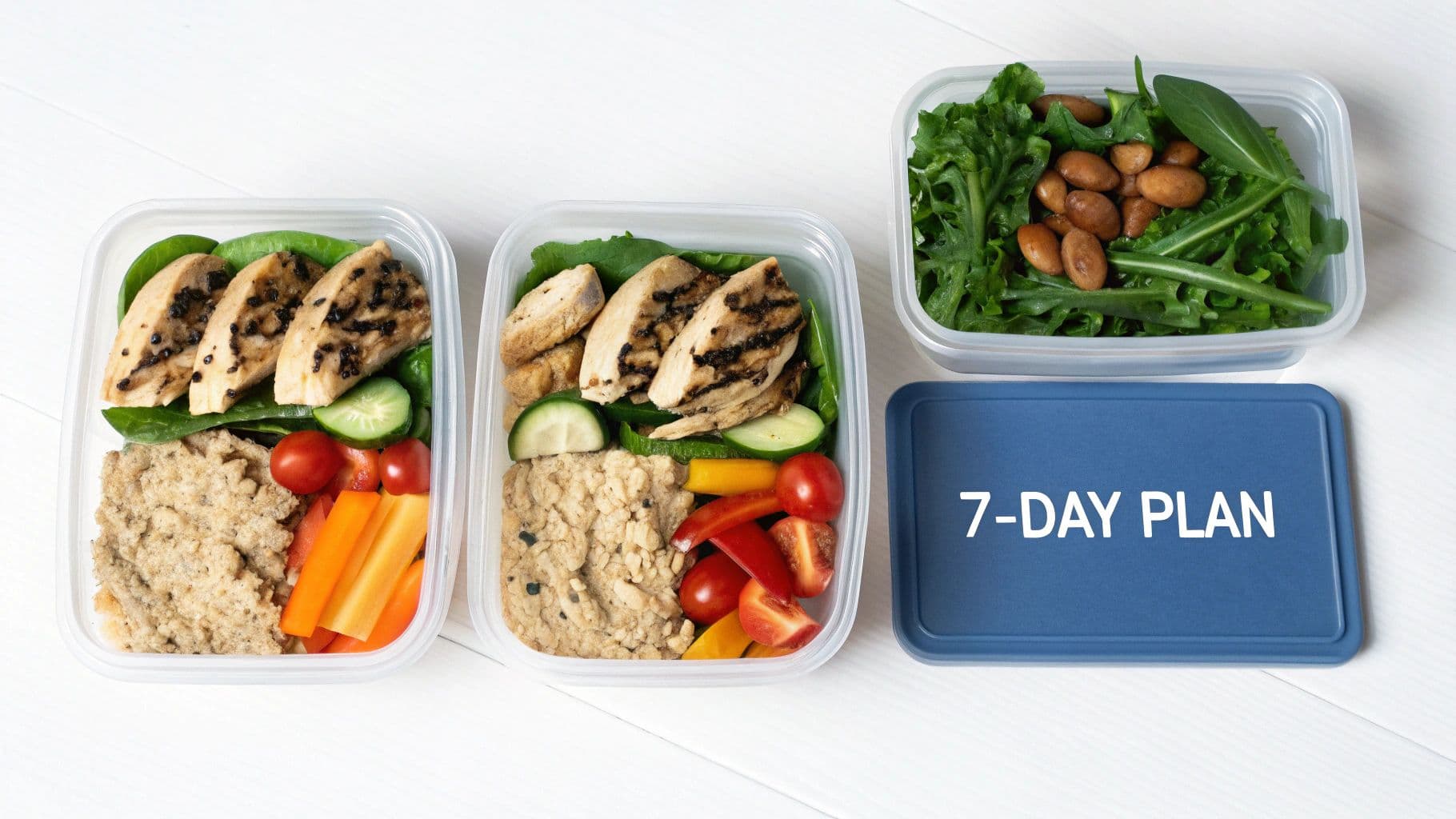
Alright, enough with the theory—let's get some food on the table! Stepping into clean eating can feel like a massive change, but I promise your first week doesn't have to be some monumental, complicated affair. The real goal here is to build a little momentum with simple, delicious meals that make you feel fantastic without chaining you to the stove.
Think of it as a fun, week-long experiment. You're just swapping out a few processed items for whole foods to see how good your body is actually designed to feel. To give you a running start, we've sketched out a sample plan to show you just how easy (and tasty) this can be.
Keep It Simple and Delicious
The secret to nailing your first week is all about keeping things easy. We're talking quick-to-prepare meals that are absolutely packed with flavor. You don't need a pantry full of exotic ingredients or a stack of complicated cookbooks. Just start with the basics: lean proteins, a rainbow of veggies, and good-for-you fats.
And let's be real, sometimes life throws a curveball and a home-cooked meal just isn't happening. That’s perfectly okay! The demand for convenient, healthy food is exploding for a reason. In fact, the healthy takeout market is expected to skyrocket to nearly USD 63.83 million by 2035, thanks to people who want nutritious meals without the prep time. You can read more about the healthy takeout market's growth if you're curious.
For the days you are cooking, think of the table below as your launchpad, not a rigid rulebook. Feel free to mix and match or swap things based on what you’re craving!
Pro Tip: Cook once, eat twice! Seriously, this is the ultimate time-saver. Make a bigger batch of dinner and pack the leftovers for a no-fuss, ready-to-go lunch the next day. It’s the best clean eating hack for busy people.
Ready to see what this looks like in action? Here are some simple ideas to get you through the week.
Sample 7-Day Clean Eating Meal Ideas
This table is just a starting point to spark some inspiration. Remember, the best plan is the one you'll actually stick with, so feel free to get creative!
| Day | Breakfast | Lunch | Dinner |
| Monday | Overnight oats with berries | Leftover salmon and veggies | Baked salmon with asparagus |
| Tuesday | Scrambled eggs with spinach | Quinoa salad with chickpeas | Grilled chicken with roasted broccoli |
| Wednesday | Greek yogurt with nuts | Leftover chicken and broccoli | Lentil soup with a side salad |
| Thursday | Smoothie with fruit and kale | Tuna salad (in lettuce cups) | Turkey meatballs with zucchini noodles |
| Friday | Whole-grain toast with avocado | Leftover turkey meatballs | Shrimp stir-fry with brown rice |
| Saturday | Oatmeal with sliced banana | Large salad with grilled chicken | Steak with sweet potato fries |
| Sunday | Veggie omelet | Leftover steak and salad | Roast chicken with mixed veggies |
See? No rocket science involved. Just real, delicious food that leaves you feeling energized and ready to take on whatever comes your way. Enjoy the process
Got Questions About Clean Eating? We’ve Got Answers.
Okay, let's get real for a second. Knowing the "rules" of clean eating is one thing, but making it work in the real world? That's a whole different ball game. What do you do when your friends invite you out for pizza night? Or when that late-night craving for something sugary hits hard?
Don't sweat it. These are the exact situations everyone runs into. Let's walk through some of the most common curveballs you'll face.
Can I Still Go Out to Eat?
Of course! A social life is non-negotiable. Eating out is totally possible; you just need to become a bit of a menu detective.
Here are a few tricks of the trade:
- Play word association: Look for menu descriptions like "grilled," "steamed," or "baked." If you see "fried," "crispy," or "creamy," it’s usually a sign to steer clear.
- Be the boss of your sauce: Always ask for dressings and sauces on the side. This simple move puts you in complete control, preventing your healthy salad from being drowned in a sugary dressing.
- Swap it out: Don't be afraid to ask for a side of steamed veggies or a simple salad instead of fries. Most places are happy to do it—it's a super common request!
Does Everything Have to Be Organic?
Nope, not at all. While going organic is great if it fits your budget, it's definitely not the all-or-nothing rule of clean eating. The main goal here is just to eat more whole fruits and vegetables.
A smart way to approach this is by using the "Dirty Dozen" and "Clean Fifteen" lists as your guide. Splurge on the organic versions of produce known for higher pesticide levels, and feel free to buy the conventional versions of everything else. It’s about being smart with your money, not chasing perfection.
Let’s be clear: the goal is to eat whole, minimally processed foods. A regular, non-organic apple is always going to be a million times better for you than a processed fruit snack packed with weird ingredients.
Seriously, How Do I Stop Craving Sugar?
Ah, the sugar monster. We all know it. Those first few weeks can feel like a battle, but that’s just your body getting used to a new normal. Instead of caving and grabbing a candy bar, try to outsmart the craving with natural sweetness.
A perfectly ripe peach, a handful of sweet berries, or even a small square of really good dark chocolate (think 70% cacao or higher) can do the trick. Drinking plenty of water helps, too!
Trust me, stick with it. Your taste buds will actually change over time, and those intense cravings for junky sweets will start to disappear.
---
Ready to make this whole meal planning thing a breeze? Meal Flow AI can whip up personalized meal plans and even create an automatic Instacart shopping list for you. It takes all the guesswork out of eating clean. Start streamlining your meals today at Meal Flow AI!